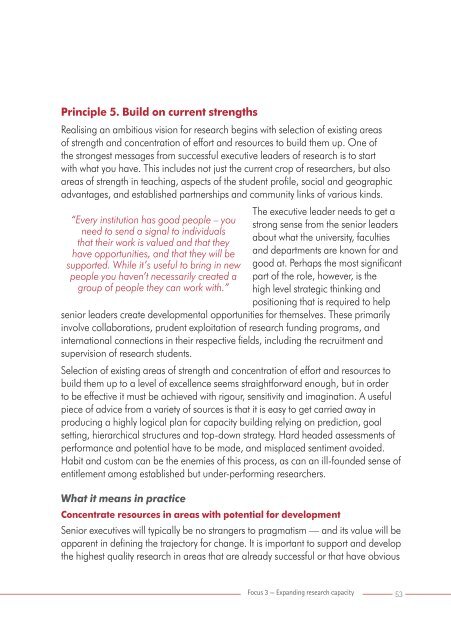handbook-executive-leadership-of-research-development-pdf-v10
handbook-executive-leadership-of-research-development-pdf-v10
handbook-executive-leadership-of-research-development-pdf-v10
Create successful ePaper yourself
Turn your PDF publications into a flip-book with our unique Google optimized e-Paper software.
Principle 5. Build on current strengthsRealising an ambitious vision for <strong>research</strong> begins with selection <strong>of</strong> existing areas<strong>of</strong> strength and concentration <strong>of</strong> effort and resources to build them up. One <strong>of</strong>the strongest messages from successful <strong>executive</strong> leaders <strong>of</strong> <strong>research</strong> is to startwith what you have. This includes not just the current crop <strong>of</strong> <strong>research</strong>ers, but alsoareas <strong>of</strong> strength in teaching, aspects <strong>of</strong> the student pr<strong>of</strong>ile, social and geographicadvantages, and established partnerships and community links <strong>of</strong> various kinds.“Every institution has good people – youneed to send a signal to individualsthat their work is valued and that theyhave opportunities, and that they will besupported. While it’s useful to bring in newpeople you haven’t necessarily created agroup <strong>of</strong> people they can work with.”The <strong>executive</strong> leader needs to get astrong sense from the senior leadersabout what the university, facultiesand departments are known for andgood at. Perhaps the most significantpart <strong>of</strong> the role, however, is thehigh level strategic thinking andpositioning that is required to helpsenior leaders create <strong>development</strong>al opportunities for themselves. These primarilyinvolve collaborations, prudent exploitation <strong>of</strong> <strong>research</strong> funding programs, andinternational connections in their respective fields, including the recruitment andsupervision <strong>of</strong> <strong>research</strong> students.Selection <strong>of</strong> existing areas <strong>of</strong> strength and concentration <strong>of</strong> effort and resources tobuild them up to a level <strong>of</strong> excellence seems straightforward enough, but in orderto be effective it must be achieved with rigour, sensitivity and imagination. A usefulpiece <strong>of</strong> advice from a variety <strong>of</strong> sources is that it is easy to get carried away inproducing a highly logical plan for capacity building relying on prediction, goalsetting, hierarchical structures and top-down strategy. Hard headed assessments <strong>of</strong>performance and potential have to be made, and misplaced sentiment avoided.Habit and custom can be the enemies <strong>of</strong> this process, as can an ill-founded sense <strong>of</strong>entitlement among established but under-performing <strong>research</strong>ers.What it means in practiceConcentrate resources in areas with potential for <strong>development</strong>Senior <strong>executive</strong>s will typically be no strangers to pragmatism — and its value will beapparent in defining the trajectory for change. It is important to support and developthe highest quality <strong>research</strong> in areas that are already successful or that have obviousFocus 3 — Expanding <strong>research</strong> capacity53



